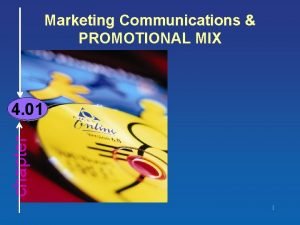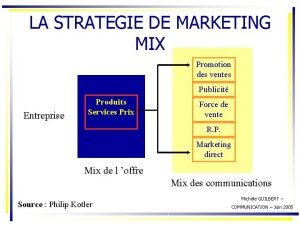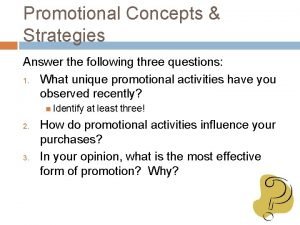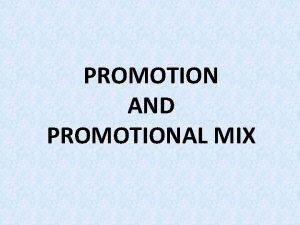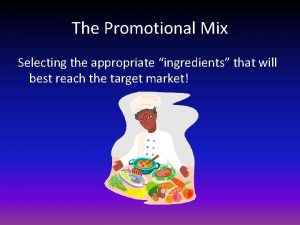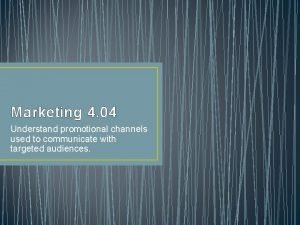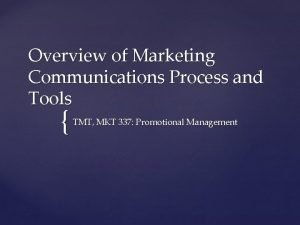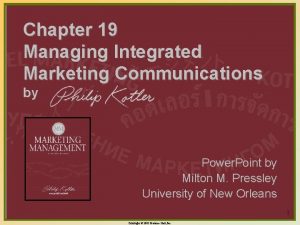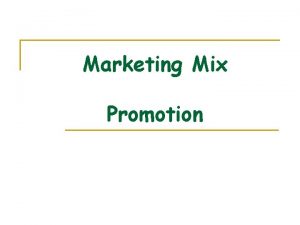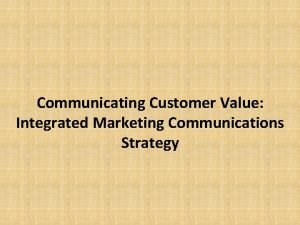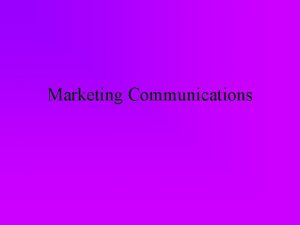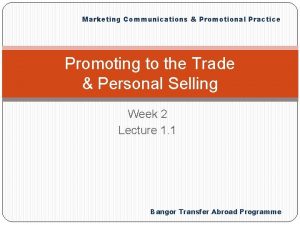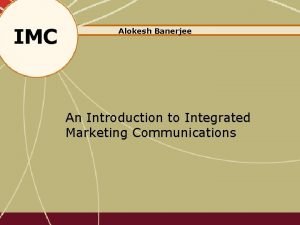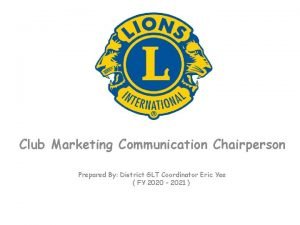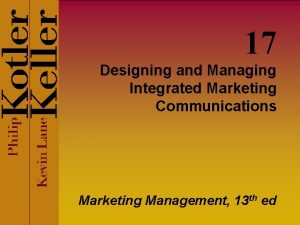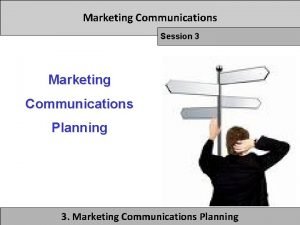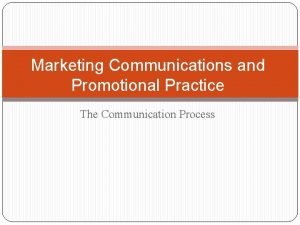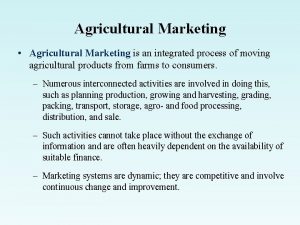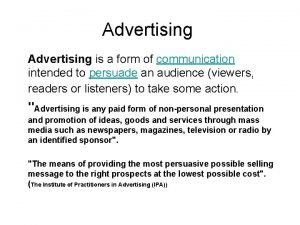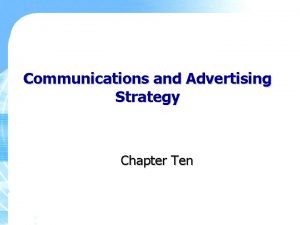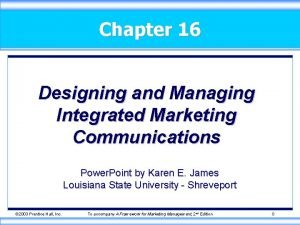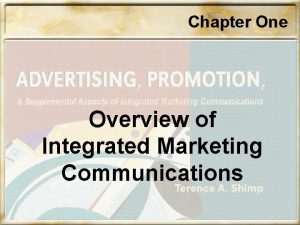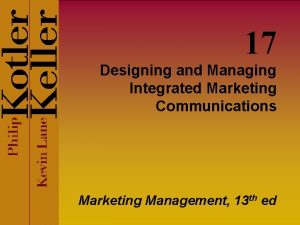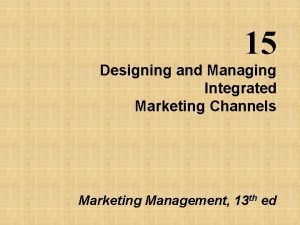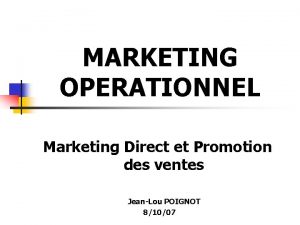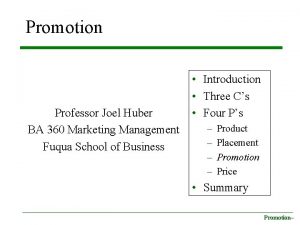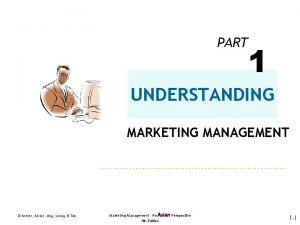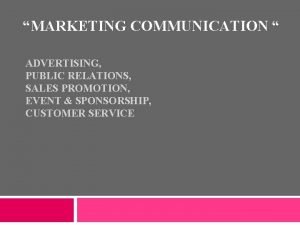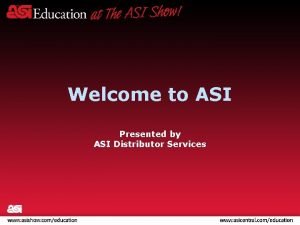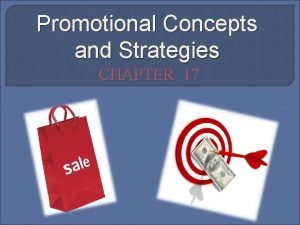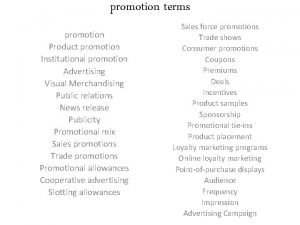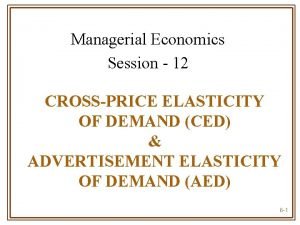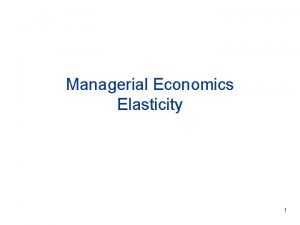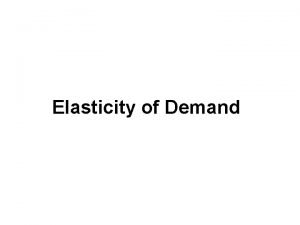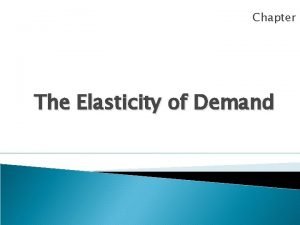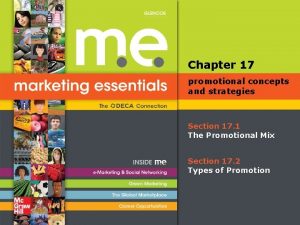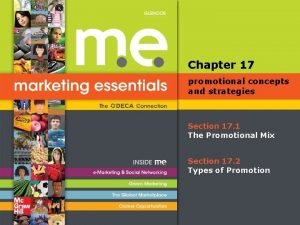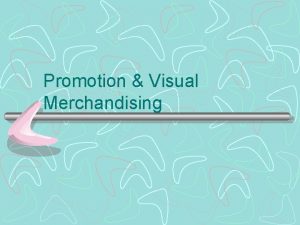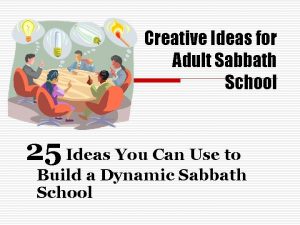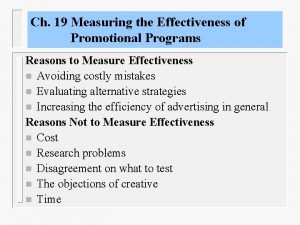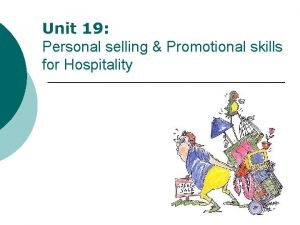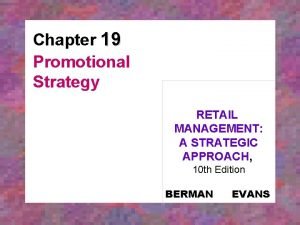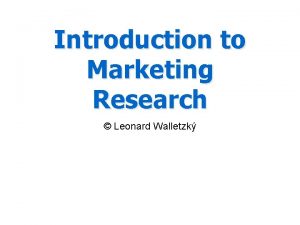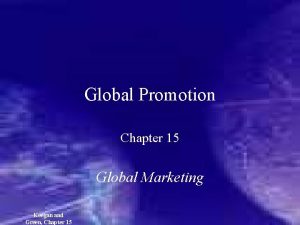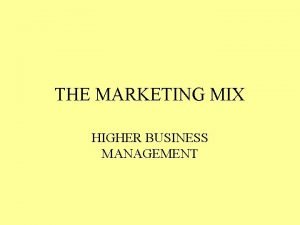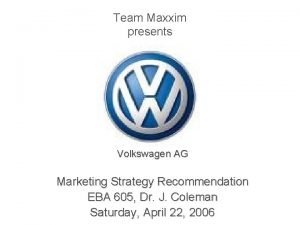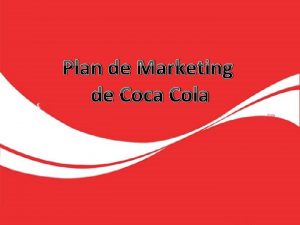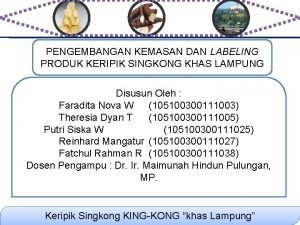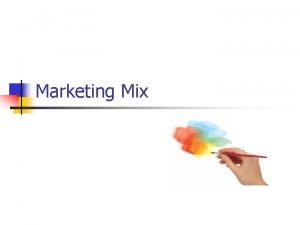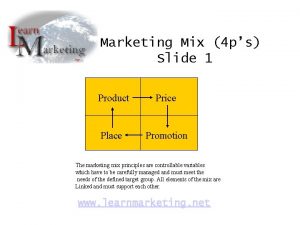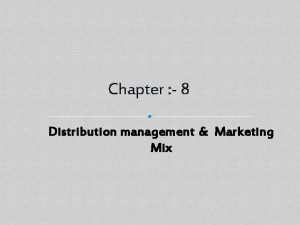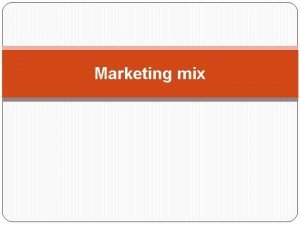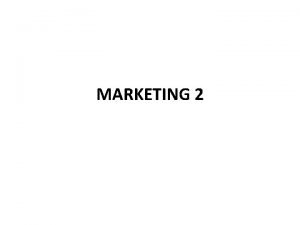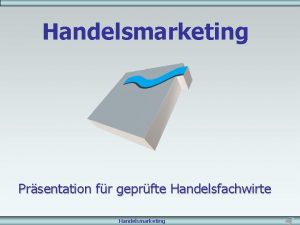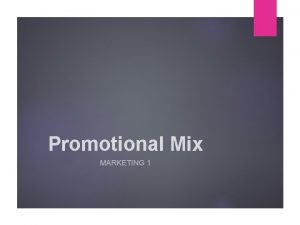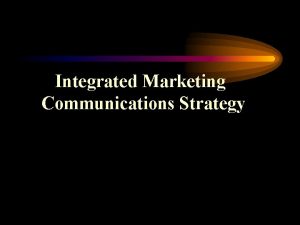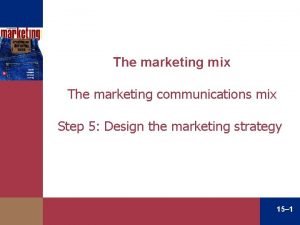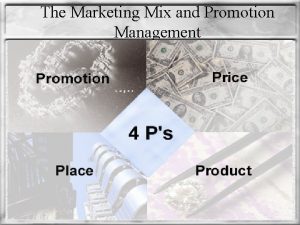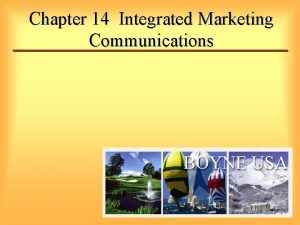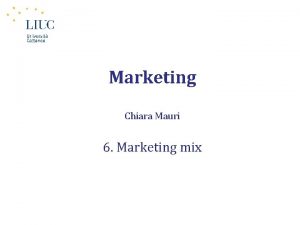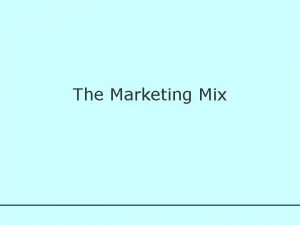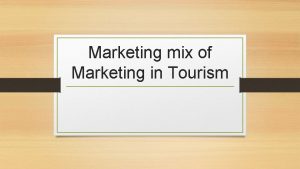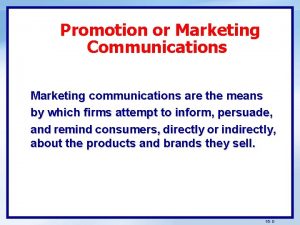Promotional Mix The Promotion Mix Marketing communications are






































































































- Slides: 102

Promotional Mix

The Promotion Mix

Marketing communications are the means by which firms attempt to inform, persuade, and remind consumers - directly, or indirectly about the products and brands that they sell

Promotion Mix is the specific blend of advertising, sales promotion, public relations, personal selling, and direct-marketing tools that the company uses to persuasively communicate customer value and build customer relationships.

Marketing Communications Mix Advertising : Any paid form of non-personal presentation and promotion of ideas, goods or services by an identified sponsor. • Sales Promotion : Short-term Incentives to Encourage Trial or Purchase. Public Relations : Protect and/or Promote Company’s Image/products. • Personal Selling : face to face communication , Personal Presentations. • Direct Marketing : Direct Communications With Individuals to Obtain an Immediate Response. • •

Ways to Handle Advertising Sales Departments in Small Companies Advertising Departments in Larger Companies. Advertising Agency Firm that Assists Companies in Planning, Preparing, Implementing and Evaluating Their Advertising Programs.

Five M’s of Advertising

Major Decisions in Advertising Marketing management must make four important decisions when developing an advertising program. 8

Advertising objective An advertising objective is a specific communication task and achievement level to be accomplished with a specific audience in a specific period of time.

Setting Advertising Objectives Informative advertising. is used when introducing a new product category; the objective is to build primary demand. Persuasive Advertising Is important with increased competition to build selective demand. Reminder Advertising. Is important with mature products to help maintain customer relationships and keep customers thinking about the product. Reinforcement Advertising. Aims to convince current purchasers that they made the right choice.

Informative objective

Persuasive objective

Persuasive objective examples Persuasive could be Comparison or Competitive. Comparison. Competitive. 13

Persuasive Example:

Reminder Objective

Reminder objective Examples

Reinforcement Example Automobile ads often depict satisfied customers enjoying special features of their new car. 17

Deciding on Budget In this advertising world, everyday we see many advertisement of different products or brands. Organizations invests heavily in advertising to make their product popular and to increase sales. But, here the questions are How much to advertise ? � How much to invest in advertisement ? � What should be the size of advertising budget? �

Deciding on Budget Advertising Budget Is an estimated amount an organization decides to invest in its promotional expenditures over a period of time. An advertising budget is the money a company set aside to accomplish its marketing objectives. Advertising Budget Methods: � Affordable Approach � Percentage of Sales � Competitive-Parity � Objective-and-Task 19

1. Affordable Approach This method is also called “All you can afford” procedure used to set advertising budgets, based on what the advertiser thinks it can afford to spend. 2. Percentage of Sales This method an advertiser takes a percentage of either past or anticipated sales and allocates that percentage of the overall budget to advertising. 3. Competitive-Parity Involves examining how much competitors are spending on marketing (and promotion) and matching or exceeding that spend.

4. Objective-and-Task The most logical budget setting method is the objective and task method whereby the company sets its promotion budget based on what it wants to accomplish with promotion. The approach consists of three steps i. Defining the communications objectives that are to be accomplished ii. Determining the specific strategies and tasks needed to attain them. iii. Estimating the costs associated with performance of these strategies and tasks. The total budget is based on the accumulation of these costs.

Setting the Advertising Budget Factors

Five factors to be considered when setting the advertising budget: Stage in the product life cycle New products typically merit large advertising budgets to build awareness and to gain consumer trial. Established brands usually are supported with lower advertising budgets. Market share and consumer base High-market-share brands usually require less advertising expenditure as a percentage of sales to maintain share. To build share by increasing market size requires larger expenditures.

Competition and clutter In a market with a large number of competitors and high advertising spending, a brand must advertise more heavily to be heard. Even simple clutter from advertisements not directly competitive to the brand creates a need for heavier advertising. Advertising frequency The number of repetitions needed to put the brand’s message across to consumers has an obvious impact on the advertising budget. Product substitutability Brands in less-differentiated or commodity-like product classes (beer, soft drinks, banks, and airlines) require heavy advertising to establish a unique image.

Deciding on Budget Product life-cycle stage � � New products require larger budgets. Mature brands require lower budgets. Market share � � � Building or taking market share requires larger budgets. Markets with heavy competition or high advertising clutter require larger budgets Undifferentiated brands require larger budgets

Developing Advertising Strategy Advertising strategy accomplishes its advertising objectives and consists of: is the strategy by which the company � � Creating advertising messages. Selecting advertising media.

Developing Advertising Strategy Advertisements need to be better planned, more imaginative, more entertaining, and more rewarding to consumers in terms of What is said, and How it is said? What is said? Referred to the ‘Big Idea’, and will normally address the key benefits sought by the target audience, motivating the audience to pay attention. How it is said? Deciding upon the content, style and tone of the advertising message, the media through which the message will be communicated to the target audience must also be selected.

Creating the Advertising Message

Creating the Advertising Message 1. Message generation(strategy) The general message that will be communicated to consumers which Identifies consumer benefits. 2. Creative concept • • "Message Evaluation and selection“ Is the idea that will bring the message strategy to life and guide specific appeals to be used in an advertising campaign. Characteristics of the appeals include: • • • Meaningful Believable Distinctive

Creating the Advertising Message 3. Message Execution when the advertiser turns the big idea into an actual ad execution that will capture the target market’s attention and interest. The creative team must find the best approach, style, tone, words, and format for executing the message.

Message Execution

Slice of life Example Is an advertising technique where a real life problem is presented in a dramatic situation and the item being advertised becomes the solution to the problem.

Scientific Evidence Example Colgate toothpaste has used scientific evidence to better confident to convince buyers that Colgate is better than other brands at fighting cavities.

Technical Expertise Example This style shows the company’s expertise in making the product. �

Life Style Example

Selecting Advertising Media

Selecting Advertising Media The Role Is to find out the right path to transfer the message to the targeted customers. The basic intention of media strategy is not only procuring customers for their product but also placing a right message to the right people on the right time. 37

Step 1. Decide on Reach , Frequency and Impact. • • • Reach (R). The number of different persons or households exposed to a particular media schedule at least once during a specified time period Frequency (F). The number of times within the specified time period that an average person or household is exposed to the message Impact (I). The qualitative value of an exposure through a given medium.

Reach Is most important when 1. launching new products, 2. extensions of well known brands, 3. frequently purchased brands; or when going after an undefined target market. Frequency Is most important where there are 1. strong competitors, 2. a complex story to tell, 3. high consumer resistance,

Step 2. Choosing Among Major Media Types 1. 2. 3. 4. 5. 6. 7. 8. 9. 10. 11. Newspapers Television Direct mail Radio Magazines Outdoor Yellow Pages Newsletters Brochures Telephone Internet

Choosing Among Major Media Types Television advantages Combines sight, sound , and motion; appealing to the senses; high attention; high reach limitations High absolute cost; high clutter; fleeting exposure; less audience selectivity • Radio Advantages Mass use; high geographic and demographic selectivity; low cost Limitations Audio presentation only; lower attention than television; nonstandardized rate structures; fleeting exposure •

Choosing Among Major Media Types Outdoor advantages • Flexibility; high repeat exposure; low cost; low competition. limitations Limited audience selectivity; creative limitations

Place Advertising out-of-home advertising, is a broad category including many creative and unexpected forms to grab consumers attention. The rationale is that marketers are better off reaching people where they work, play, and, of course, shop.

PLACE ADS • • Billboards: Digitally produced graphics , backlighting, sounds , movement , and unusual—even 3 D—images. Public spaces : Advertisers have been increasingly placing ads in unconventional places such as on movie screens, on airplanes, and in fitness clubs. Product placement : An advertising technique used by companies to promote their products through a nontraditional advertising technique, usually through appearances in film, television, or other media. Point-of-purchase : Marketing materials or advertising placed next to the merchandise it is promoting. These items are generally located at the checkout area or other location where the purchase decision is made.

Billboards Examples 45

Public spaces Example 46

Product placement Examples 47

Point-of-purchase Example 48

Step 3. Selecting Specific Media Vehicles. The media planner must search for the most cost-effective vehicles within each chosen media type. Media vehicle refers to specific methods of media used by companies to deliver advertising messages to targeted customers. In making choices, the planner must rely on measurement services that estimate audience size, composition , and media cost

Selecting Specific Media Vehicles. Audience size has several possible measures: • • Circulation Audience Effect audience Effective ad-exposed audience

Step 4. Deciding on Media Timing The advertiser must also decide how to schedule the advertising over the course of a year. When deciding on media timing, the planner must consider: • • Seasonality Pattern of the advertising

Pattern of the advertising In launching a new product, the advertiser must choose among continuity, concentration , flighting, and pulsing. Continuity means exposures appear evenly throughout a given period. Generally, advertisers use continuous advertising in expanding market situations, with frequently purchased items, and in tightly defined buyer categories. This is a best model for the products having continuous demand all the year round. Concentration calls for spending all the advertising dollars in a single period. This makes sense for products with one selling season or related holiday.

Flighting calls for advertising during a period, followed by a period with no advertising, followed by a second period of advertising activity. It is useful when funding is limited, the purchase cycle is relatively infrequent , or items are seasonal. Pulsing This model is the combination of both continuity and flighting scheduling. Here, ads run whole year round but at a lower side that means less ads.

Step 5. Deciding on geographical Media allocation. The company makes “ notional buys “ when it placed advertising on national TV net or in nationally circulated magazines. The company makes “ local buys “ when it placed advertising on local newspapers, radio, or outdoor site.

Advertising Evaluation

1. Communication Effect Research: called copy testing Three major methods of adverting pretesting • Direct Rating Method: consumers to rate alternate ads • Portfolio tests: test consumers recall level by exposing to • Laboratory tests: uses equipment to measure plethora of ads physiological reactions

2. Sales Effect Research This is harder to measure than above. A company’s share of advertising expenditures produces a share of voice that produces a share of minds and hearts and ultimately a share of market. Researchers try to measure the sales impact through analyzing Historical Approach Experimental design

Public Relations • • Building good relations with the company’s various publics by obtaining favorable publicity, building up a good “corporate image” and handling or heading off unfavorable rumors, stories and events. Public relations (PR) includes a variety of programs designed to promote or protect a company’s image or its individual products. • Public relations is used to promote product, people, ideas, and activities

PR. Major Functions 1. Press relations or press agency involves the creation and placing of newsworthy information to attract attention to a person, product, or service. 2. Product publicity involves publicizing specific products. 3. Public affairs involves building and maintaining national or local community relations. 4. Lobbying involves building and maintaining relations with legislators and government officials to influence legislation and regulation. 5. Investor relations involves maintaining relationships with shareholders and others in the financial community. 6. Development involves public relations with donors or members of nonprofit organizations to gain financial or volunteer support. 59

Major Public Relations Decisions • • Setting Public Relations Objectives. Choosing the Public Relations Messages and Vehicles. Implementing the Public Relations Plan. Evaluating Public Relations Results.

Public Relations Tools The Main Tools Of PR Are 1. 2. 3. 4. 5. 6. 7. publications, events, news, Sponsorships, speeches , identification media and Public Service Activities.

Publications: Companies rely extensively on published materials to reach and influence their target markets. These include annual reports , brochures , articles , company newsletters and magazines , and audiovisual materials. • Events: Companies can draw attention to new products or other company activities by arranging and publicizing special events such as news conferences , seminars , outings , trade shows , exhibits, contests and competitions , and anniversaries that will reach the target publics. • • Sponsorships: Companies can promote their brands and corporate name by sponsoring and publicizing sports and cultural events and highly regarded causes

• • News: One of the major tasks of PR professionals is to find or create favorable news about the company , Its products , and its people and to get the media to accept press releases and attend press conferences. Speeches: Increasingly , company executives must field questions from the media or give talks at trade associations or sales meetings , and these appearances can build the company’s image. Public Service Activities: Companies can build goodwill by contributing money and time to good causes. Identity Media: Companies need a visual identity that the public immediately recognizes. The visual identity is carried by company logos , stationery , brochures , signs , business forms , business cards, buildings , uniforms , and dress codes.

What is Sales Promotion? Sales promotions consist of a collection of incentive tools, mostly short term, designed to stimulate, motivate and influence the purchase and other desired behavioral responses of the firm’s customers. From the above definition one can understand the following characteristics of Sales Promotion 1. 2. 3. It is mostly short term in nature. Its only objective is to promote sales quickly. Sales promotion is done with channel partners as well as the customers 64

Sales Promotion Advantages of Sales Promotion Ø Ø Ø It is often has eye catching appeal Themes and tools can be distinctive The consumer may receive something of value, such as coupons or free merchandise It helps to draw customer traffic and maintain loyalty to the retailer Impulse purchase are increased Customers can have fun, particularly with contests and demonstrations.

What is the differences between advertising and promotion

Developing the Sales Promotion Program Decide on the Size of the Incentive Set Conditions for Participation Determine How to Promote and Distribute the Promotion Program Determine the Length of the Program Evaluate the Program 67

Consumer Promotion Short-Term Incentives to Encourage Purchase or Sales of a Product or Service Consumer-Promotion Objectives Entice Consumers to Try a New Product Lure Customers Away From Competitors’ Products Get Consumers to “Load Up’ on a Mature Product Hold & Reward Loyal Customers Consumer Relationship Building

Business - Promotion Tools Short-Term Incentives That are Directed to Industrial Customers. Business-Promotion Objectives Tools Generate Business Leads Stimulate Purchases Reward Customers Motivate Salespeople Conventions Trade Shows Sales Contests 69

Consumer-Promotion Tools Samples Coupons Free Trials Patronage Rewards Cash Refunds Contests Price Packs Sweepstakes Premiums Games Point-of-Purchase Displays

CC ashs h Re Rfeaufsn ud nsds Co up e ce i r c e i P P Prriaccckksss Pack P Pa on s e Fre les mp a S TOOLS OF SALES PROMOTION Pre mi um s

ØFree § § § Samples: Offer a free amount of product or service Increase sales volume at the early stage of the product life cycle and obtain desirable distribution. Most expensive sales promotion technique. ØCoupons: Certificate entitling the bearer to a stated saving on the purchase of a special product

Ø Premiums (gifts): an offer of an item of merchandise or service either free or at a low cost that is an extra incentive for customers Prizes (contests, sweepstakes, games): prices offers to win cash, trips or merchandise as a result of purchasing something § Contests: calls for consumers to submit an entry to be examined by judges who will select the best entries § Sweepstakes : ask customers to submit their names in a draw § Game : presents consumers with something every time they buy Ex: bingo numbers with missing letter that help customers to win a prize Ø

Ø Cash Refunds: provide a price reduction after purchase rather than at the retail shop, customer submit “proof of purchase” to the manufacture who refunds part of the purchase by email. Ø Free Trials : inviting prospective purchasers to try the product without cost in the hope that they will buy. Ø Patronage Award : value in cash or other forms that are proportional to patronage of certain vendor or group of vendors.

Ø Cross promotions: Ø Point of Purchase Display: Ø Price Packs : offer consumer saving off the using one brand to advertise another noncompeting brand. Displays and demonstrations take place at the point of purchase or sale. regular price of product, flagged on the label package , a reduced-price pack is a single package sold at a reduced price such as(two for the price of one).

Business - Promotion Tools Ø Trade shows and conventions : An exhibition organized so that companies in a specific industry can showcase and demonstrate their latest products, service, study activities of rivals and examine recent market trends and opportunities.

Sales contest aims at inducing the sales force or dealers to increase their sales results over a stated period with prices trips gifts or points going to those who succeed.

Specialty advertising Ø consists of useful low cost items bearing the company’s name and address , sometimes advertising message that salespeople give to prospects and customers. Common items are ballpoint pens key chains flashlights, tote bags and memo pads

Direct marketing � Direct marketing is the use of consumer-direct channels � Direct marketing to reach and deliver goods and services to customers without using market middlemen. Connecting directly with carefully targeted individual consumers to both obtain an immediate response and cultivate lasting customer relationships.

Direct Marketing Tools Direct Mail Digital Interactive Marketing Personal Selling Catalogs Direct Marketing Direct. Response Television Marketing Telemarketing

Ø Ø Direct-mail marketing : involves sending an offer, announcement, reminder, or other item to a person at a particular physical or virtual address. Using highly selective mailing lists, direct marketers send out millions of mail pieces each year—letters, catalogues, ads, brochures, samples, CDs and DVDs, and other “salespeople with wings. ”

Ø Catalogue marketing Direct marketing through print, video, or digital catalogues that are mailed to select customers, made available in stores, or presented online. § § Today catalogues are also available online. Printed catalogues are still popular and works as a good supplement.

Ø Telephone marketing Using the telephone to sell directly to customers. § Divided into two types ◦ Inbound telemarketing A division of customer service, the department that answers customers’ questions when they call in. ◦ Outbound telemarketing The department of marketers who place outgoing calls, usually to existing customers, to try to persuade them to upgrade their services.

Ø Direct-Response Television spots that persuasively describe a product and give customers a toll-free number for ordering. § Uses formats such as : ◦ Infomercials – longer advertising programs. ◦ The Shopping Channel – channels devoted to facilitate buying goods.

Digital Interactive Marketing � � is a marketing campaign that takes place using a digital platform , that uses of electronic devices such as personal computers, smart phones, cell phones, tablets TV and game consoles to engage with stakeholders. Some new alternative terms used include, new media marketing, interactive marketing, Internet marketing, electronic marketing, digital marketing, and online marketing.

Digital Interactive marketing Forms ◦ ◦ ◦ Websites Email marketing Online Marketing Search engine marketing Blogs & social networks Mobile marketing

Digital Interactive marketing Forms � Social media marketing involves both advertising and marketing (including viral marketing) efforts via social networking sites like Facebook, Twitter, You. Tube and other social media platforms. � Websites : Companies must design websites that express their purpose , history , products and vision that are attractive on first viewing and interesting enough to encourage repeat visits

Digital Interactive Marketing Forms Online Marketing � Online marketing refers to a set of powerful tools and methodologies used for promoting products and services through the Internet. Online marketing includes a wider range of marketing elements than traditional business marketing due to the extra channels and marketing mechanisms available on the Internet. � Online marketing is also known as Internet marketing, Web marketing, digital marketing and search engine marketing (SEM).

Online marketing advantages : � � Low costs: Large audiences are reachable at a fraction of traditional advertising budgets, allowing businesses to create appealing consumer ads. Flexibility and convenience: Consumers may research and purchase products and services at their leisure. Analytics: Efficient statistical results are facilitated without extra costs.

Online marketing advantages : � � Multiple options: Advertising tools include pay-per-click advertising, email marketing and local search integration (like Google Maps). Demographic targeting: Consumers can be demographically targeted much more effectively in an online rather than an offline process.

Email marketing § § is directly marketing a commercial message to a group of people using email. the term is referring to sending email messages with the purpose of enhancing the relationship of a merchant with its current or previous customers, to encourage customer loyalty and repeat business, acquiring new customers or convincing current customers to purchase something immediately

Marketing Emails Types � Promotional Email To promote a product or service, usually to entice customers to make a purchase. � New Inventory Email To let your customers know about new items. It falls under the promotional email umbrella. updating customers, but also hoping for a sale.

Marketing Emails Types � Newsletter Email To inform customers about company news, improve brand awareness and build a relationship with your core audience. � Educational Email To provide customers with industry knowledge that’s connected to your business or product. It helps build relationships and trust between your business and your customers.

Marketing Emails Types � Survey Email To collect helpful information you can use to improve the customer experience. � Reorder Email To remind customers that it’s time to reorder a certain product. � Welcome Email To welcome new email subscribers to the family and establish a good relationship

Mobile marketing use of various mobile technologies to communicate to a given target audience. � � Mobile marketing can provide customers with time and location sensitive, personalized information that promotes goods, services and ideas � SMS Mobile Marketing through cell-phones � MMS mobile marketing can contain a timed slideshow SMS (Short Message Service) became increasingly popular in the early 2000 s in Europe and some parts of Asia of images, text, audio and video. This mobile content is delivered via MMS (Multimedia Message Service)

Personal Selling personal selling involves interpersonal interactions between salespeople and individual customers , These interpersonal interactions can take form of face to face, by phone, through video, web conference, and through an online messenger

Salesperson Roles � � Salespeople play an important role in representing a company and gaining customers trust. Through salespeople, companies are able to build long lasting and loyal relationships with their customers In many cases, customers decide to shop at a specific store only because of the relationships that they have built with that store’s salespeople represents customers to the company and help achieve the overall goalcustomer satisfaction and company profit

Positions covered by sales representative � Deliverer : sales person whose major tasks is delivery of product Order taker : inside order taker ( who standing behind the counter ) , outside order taker � � � Missionary : salesperson whose responsible to build goodwill or educate the actual or potential user Technician : salesperson with high level of technical knowledge (the engineering salesperson who is primarily a consultant to client companies )

Positions covered by sales representative � � Demand creator : a salesperson who relies on creative methods for selling tangible products(household products) or intangible (services , education , advertising) Solution vendor : A salesperson who expertise is solving a customer’s problem often with a system of the company’s products and services (computer and communications systems)

Personal selling process Prospecting and qualifying Preapproach Presentation and Demonstration Overcoming Objection Closing Follow-up and maintenance

Personal selling process � � • • • Prospecting and qualifying : Identify and qualify prospects (customers) Reproach : the salesperson needs to learn as much as possible about the prospect company what it needs who takes apart in purchase decision Company’s buyers (personal characteristics and buying styles )

Personal selling process • • Presentation And Demonstration : the salesperson presents the product’s features , advantages , benefits and value to the customer Overcoming Objection : when customer pose objection the salesperson asks the buyers to clarify his objection and questions Closing : obtain a purchase commitment from the prospect and create a customer Follow-up : Ensure that the customer is satisfies with the product or service
 Mikael ferm
Mikael ferm Factors affecting promotion mix
Factors affecting promotion mix Promotional mix definition
Promotional mix definition Imc mix
Imc mix Marketing mix promotion
Marketing mix promotion Price place promotion
Price place promotion Marketing plan for starbucks
Marketing plan for starbucks Promotional activites
Promotional activites Imc promotional mix
Imc promotional mix Definition of promotional mix
Definition of promotional mix Promotional techniques
Promotional techniques Selecting the promotional mix
Selecting the promotional mix What is promotion mix
What is promotion mix Product line vs product width
Product line vs product width A contest differs from a sweepstakes in that ______.
A contest differs from a sweepstakes in that ______. Communications mix
Communications mix Designing and managing integrated marketing channels
Designing and managing integrated marketing channels Setting the total promotion budget
Setting the total promotion budget Factors affecting promotion mix
Factors affecting promotion mix Push vs pull promotional strategy
Push vs pull promotional strategy Promotion mix
Promotion mix Promotion mix elementy
Promotion mix elementy Carefully blended mix of promotion tools
Carefully blended mix of promotion tools Marketing mix
Marketing mix Promotion mix introduction
Promotion mix introduction Encoding marketing
Encoding marketing Push pull profile strategies marketing communications
Push pull profile strategies marketing communications Alokesh banerjee
Alokesh banerjee Global marketing and communications
Global marketing and communications Club marketing communications chairperson
Club marketing communications chairperson Designing and managing integrated marketing communication
Designing and managing integrated marketing communication Push pull profile strategies marketing communications
Push pull profile strategies marketing communications Drip model marketing communications
Drip model marketing communications K state communications and marketing
K state communications and marketing Agricultural marketing process
Agricultural marketing process Rabostic model
Rabostic model Coca cola push and pull strategy
Coca cola push and pull strategy 6m model of marketing communications
6m model of marketing communications Designing and managing integrated marketing communications
Designing and managing integrated marketing communications Wythm
Wythm Advertising and marketing communications
Advertising and marketing communications Overview of integrated marketing communications
Overview of integrated marketing communications Designing and managing integrated marketing channels
Designing and managing integrated marketing channels Designing and managing integrated marketing channels
Designing and managing integrated marketing channels Marketing direct et de promotion des ventes
Marketing direct et de promotion des ventes Promotion through the marketing channel
Promotion through the marketing channel 360 advertising marketing & promotion
360 advertising marketing & promotion Keller
Keller Sales promotion event
Sales promotion event Esp asi search engine
Esp asi search engine 5 promotional tools
5 promotional tools Promotional activites
Promotional activites Chapter 17 promotional concepts and strategies
Chapter 17 promotional concepts and strategies Define institutional promotion
Define institutional promotion Promotional material devon
Promotional material devon Promotional forecasting in the grocery retail business
Promotional forecasting in the grocery retail business What are the 5 promotional tools
What are the 5 promotional tools Promotional elasticity of demand
Promotional elasticity of demand Promotional elasticity of demand
Promotional elasticity of demand Objectives of elasticity of demand
Objectives of elasticity of demand Types of price elasticity of demand
Types of price elasticity of demand Promotional concept
Promotional concept Examples of promotional tie ins
Examples of promotional tie ins Types of display in visual merchandising
Types of display in visual merchandising Mango languages promotional materials
Mango languages promotional materials Sabbath school program sample
Sabbath school program sample Measuring the effectiveness of promotional program
Measuring the effectiveness of promotional program Klantentypologie
Klantentypologie Objectives promotion
Objectives promotion Planning a retail promotional strategy
Planning a retail promotional strategy Product promotion form 2
Product promotion form 2 Promotional research
Promotional research Chapter 15 branding
Chapter 15 branding David blaise promotional products
David blaise promotional products Duties of personal ministries leader
Duties of personal ministries leader Mixul promotional
Mixul promotional Contoh advokasi dalam promosi kesehatan
Contoh advokasi dalam promosi kesehatan Vtc lan4108
Vtc lan4108 Promo code asdfasdg
Promo code asdfasdg Marketing mix channels of distribution
Marketing mix channels of distribution Extension strategies higher business
Extension strategies higher business Marketing mix volkswagen
Marketing mix volkswagen Blanket family branding
Blanket family branding Conclusiones de coca cola
Conclusiones de coca cola Contoh positioning produk makanan
Contoh positioning produk makanan Marketing mix ryanair
Marketing mix ryanair Analisis swot pisang coklat
Analisis swot pisang coklat Whats marketing mix
Whats marketing mix Supreme marketing mix
Supreme marketing mix Marketing mix in airline industry
Marketing mix in airline industry Elementy marketingu mix
Elementy marketingu mix Marketing mix slide
Marketing mix slide Marketing mix evaluator
Marketing mix evaluator Processus de fabrication zara
Processus de fabrication zara Pepsi product mix
Pepsi product mix Gatorade marketing mix
Gatorade marketing mix Distribution management and marketing mix
Distribution management and marketing mix 13p marketing mix
13p marketing mix Pozycjonowanie marketing
Pozycjonowanie marketing Product marketing mix
Product marketing mix 10 p marketing
10 p marketing Marketing mix module
Marketing mix module Marktziele
Marktziele

